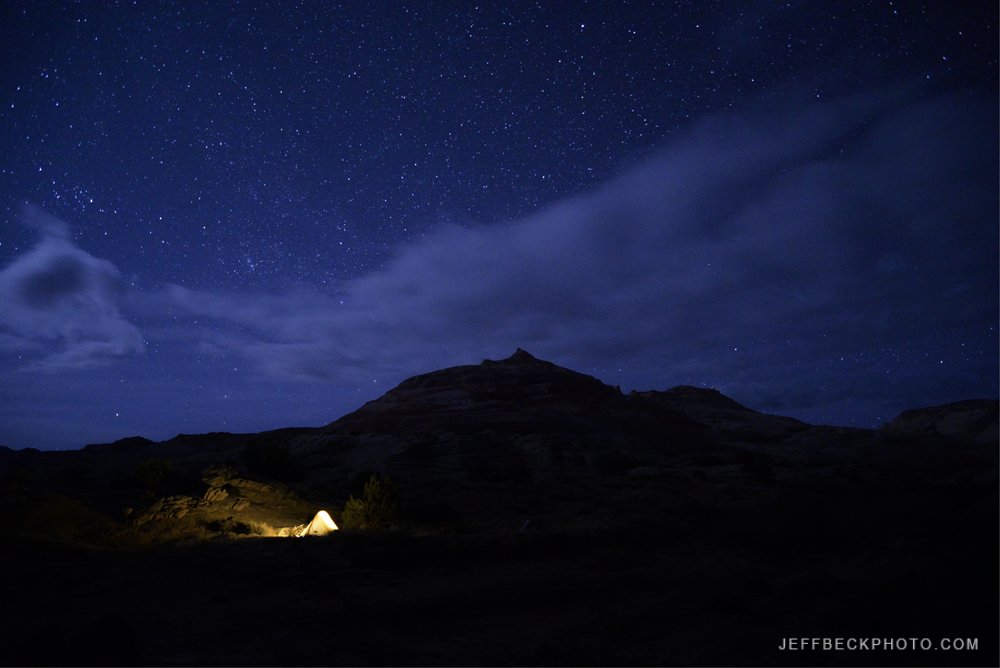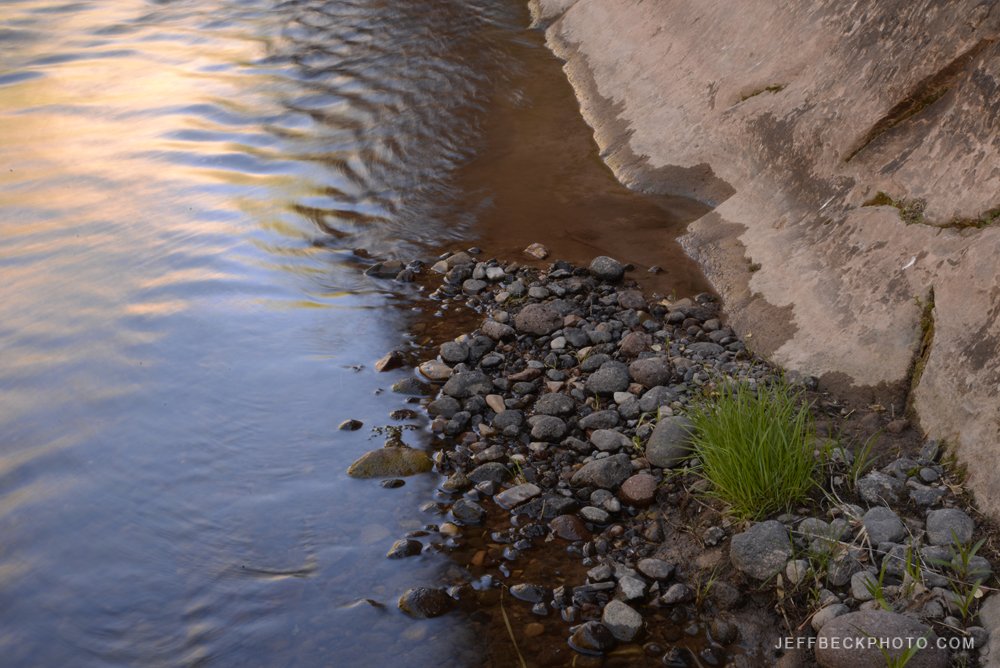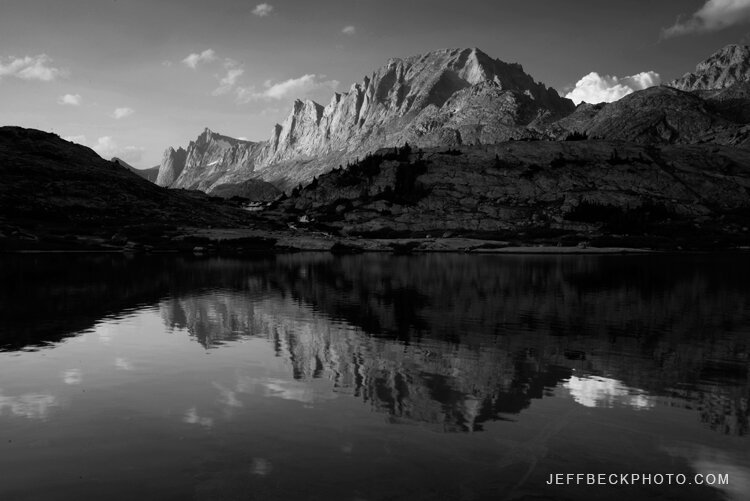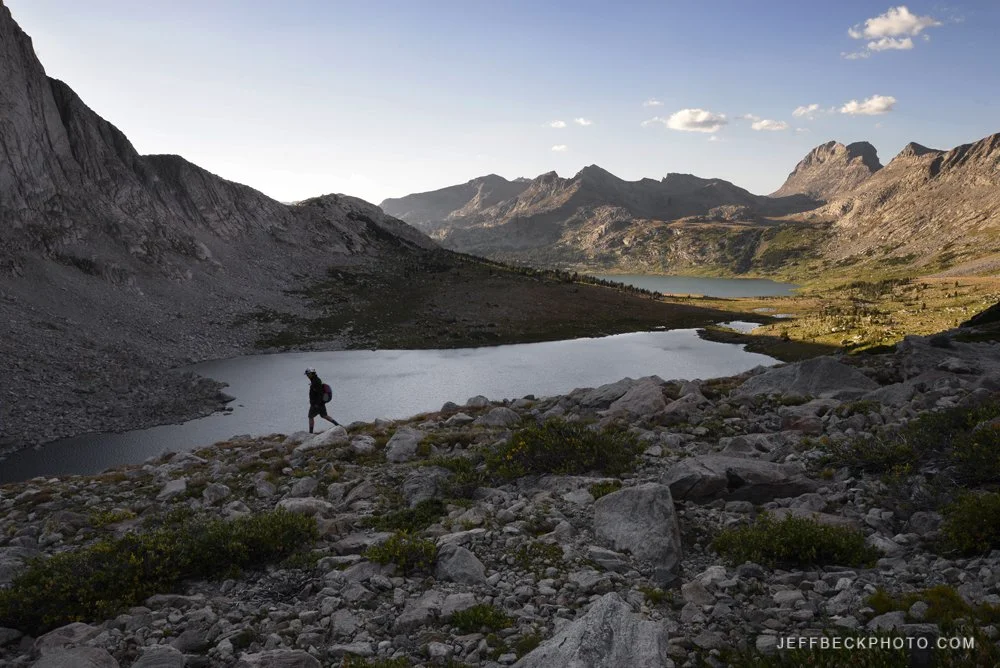Looking at these photos in December, I’m less disappointed with them than I was in April. As the intensity of the moment fades from my memory, from the tiny scorpion hanging out in the sand at the door of my tent, to the bite of a chill wind and even a few snowflakes, to the exhaustion of hours of cross-country travel, clamoring over slickrock ridges and across deep sand plains, to the dizzying ledges and walls that looked too steep to walk on, the images become better surrogates of the experience.
Wind River Range: August 2020
EB hikes beside upper Titcomb Lake, Bridger Wilderness, Wyoming
I was lucky enough to spend seven days backpacking in the Winds in late August. Making it back in to Titcomb Basin after 20 years was a highlight. As was being back in the Wind River Range with Erik and Rosalie three years after our first trek together there. August twenty years ago was my first backpack in the Winds. This was my fifth. I’m hoping to increase that frequency over the next twenty years.
Our route went from Elkhart Park past Senaca Lake and Island Lake to Titcomb Basin then back to the Highline Trail which we followed over Lester Pass and down to the Cook Lakes Loop. One of the highlights of the trip was hiking to Wall Lake from our camp at Upper Cook Lake. We finished our loop on the Pole Creek Trail past Eklund Lake and back past Photographers Point to Elkhart Park.
Titcomb Basin and vicinity was a zoo. The scenery is undeniable but at times the amount of traffic on the trail was noisy and annoying. We found a gorgeous campsite at the end of a string of lakes below Titcomb Lakes. When we got there there was one other group and we tried to give them a little room and still stay legal by not camping too close to the outlet stream. We turned around and two more groups had moved in, one on either side of us.
On the other side of Lester Pass we finally got a little solitude. It seemed like there were only two other groups in the entire Cook Lakes area while we were there. On two jaunts to Wall Lake, one in the evening by myself and then again in the morning with Erik, we didn’t see another soul.
I loved almost everything about this trip except the light. On day three thick smoke from distant wildfires filled the range and never fully cleared. Looking at my photos from our second evening, and my most productive landscape photo session of the trip, the air was already less than clear. This definitely forced me to concentrate on details which was not necessarily a bad thing. I’ve come home from many a trip to look at my photos and think, I wish I would have focused more on details instead of trying to get everything in the frame all the time.
Some of my favorite images of the trip and certainly the most colorful were of butterflies. There were a ton of butterflies flitting around high wildflower meadows. The Fritillaries were particularly abundant, but the California Tortoiseshells were the most approachable.
Fremont Peak reflected in a small lake below Titcomb Basin, Wind River Range, Wyoming
Infinite Inspiration
Purplish Copper (Lycaena helloides)
Wow. I can’t believe I managed to go an entire year without posting a single blog entry. In my mind I posted many. I may have had (have) some form of writers block, but it isn’t from a lack of inspiration to photograph the natural world. I may not have any blog posts to my credit in 2019, but I did make a number of memorable images. More importantly, I went deeper into some of my new favorite subjects: birds, butterflies, and dragonflies.
Spotted Sandpiper (Actitis macularia)
2019 was the first year I saw the difference between an eight spotted skimmer and a twelve spotted skimmer. It was actually the first year I positively identified any species of dragonfly. It was also the first year I realized there was this adorable little sandpiper high in Utah’s mountains in summer, working the edges of subalpine streams and ponds. It was also the first year I spotted the snaky orange line on the hindwing of the Purplish Copper.
Striped Meadowhawk (Sympetrum pallipes)
In order to identify the creatures I’ve captured digitally, I’ve found a few websites to be invaluable. Utah Birds is a great website with tons of photos and info on the birds of Utah and the best birding locations in the state. Butterflies and Moths of North America is my go to site for identifying butterflies, and Odonata Central has helped me overcome my trepidation trying to differentiate species of dragonfly.
One of my favorite features of all of these sites is the ability to generate a checklist at the county level. It blew me away to learn the checklists for Salt Lake County include 346 species of birds, 122 species of butterflies, and 49 distinct species of damselflies and dragonflies.
Photographing all the species from any one of those lists would be an immense challenge. The numbers made me think, the variety of subjects right in my backyard could easily provide a lifetime of photographic inspiration. I’ll try harder this year to share some of those inspirations. Thanks for visiting jeffbeckphoto.com.
Red Butte Garden Holiday Open House & Art Fair
Not quite finished…New work for the Red Butte show.
I’m excited to be back at Red Butte Garden for the 18th Annual Holiday Open House and Art Fair, Saturday and Sunday December 1st and 2nd, 2018 from 10am to 5pm. I’ll be set up in the Orangerie, selling matted, framed, and stretched canvas prints, photo note cards, and one-of-a-kind photo transfers on paper, stone, and wood. Admission to the garden is free during the open house, so bring the whole family. Hope to see you there!
Butterflies of Red Butte Garden
Anglewing Butterfly, Red Butte Garden, Utah
My most rewarding project of 2017 was photographing butterflies at Red Butte Garden. In fact, the image above of a Satyr Comma (Polygonia satyrus) is my personal favorite photo of the year. I photographed Swallowtails, Monarchs, and Greater Fritillaries during a couple of visits to Red Butte Garden over the summer, but the real action was in November.
Painted Lady, Red Butte Garden, Utah
The weather had turned warm again after an early October cold snap. Butterflies were concentrating at Red Butte Garden to get nectar from the last prolific blooms to be found anywhere around; showy pale pink chrysanthemums and purple asters. I was able to observe and photograph ten different species of butterflies on a handful of visits in late October and early November.
Painted Lady Wing Detail, Red Butte Garden, Utah
The first Autumn butterflies I noticed were Painted Ladies (Vanessa cardui). It was the Painted Ladies loving the blue hyssop in my backyard that first put the idea of going back to Red Butte Garden to photograph butterflies in my mind. When I got there I wasn't disappointed, there were a lot of Painted Ladies. I was able to capture a number of fine images, none more exquisite than the wing detail above.
Milbert's Tortoiseshell, Red Butte Garden, Utah
I was excited by a number of the butterfly images I was able to capture last year. I can also see a lot of room for improvement and exploration, which is exciting as well. Certainly some of the little guys that aren't represented here, like Coppers, Skippers, and Blues are worthy of more attention. I'm looking forward to observing butterflies even more closely this year.
Scanning 35mm Film
As I’ve been working on the new website, I realized that some of my older film scans were not migrated to newer hard drives. When I first started scanning my film, I made the mistake of scanning a lot of images at smaller sizes because I was trying to save hard drive space, and I didn’t want to clutter up my drives with full size images (100+MB) that weren’t ultimately going to be printed large.
Today, my hard drives are full of images that will never even be proofed - because they’re not good enough. With digital storage costing less than ever, it only makes sense to scan film at the highest possible resolution, creating a master image file that is sized down for proofing, instead of scanning a proof size file and rescanning if a larger file is desired, which is what I used to do.
So, rather than trying to retrieve the digital versions, I’ve been rescanning some of my 35mm slides. Images from my previous website galleries; praiseworthy images that slipped through the cracks because they're not core portfolio images. I’ve also been scanning some images that had never been transferred to digital. This has made me realize a few things.
First, I need to be more diligent with the organization and updating of my digital image library. Not migrating digital content to new media or new technology could have catastrophic consequences when there’s no hard copy original to fall back on.
Second, I have a huge collection of images on film that have rarely if ever been seen. Images that were once projected in slide shows, but have never existed in digital form, yet still deserve some attention. I need to resume scanning my best chromes, something I stopped doing once I became firmly established in my digital workflow.
Third, I should offer my services to people who want to give new life to images on film. I could put my Nikon Coolscan to work. So, if you have precious images on 35mm film (slide or negative) that you’d like to convert to jpeg and tiff, contact me to find out how.



































